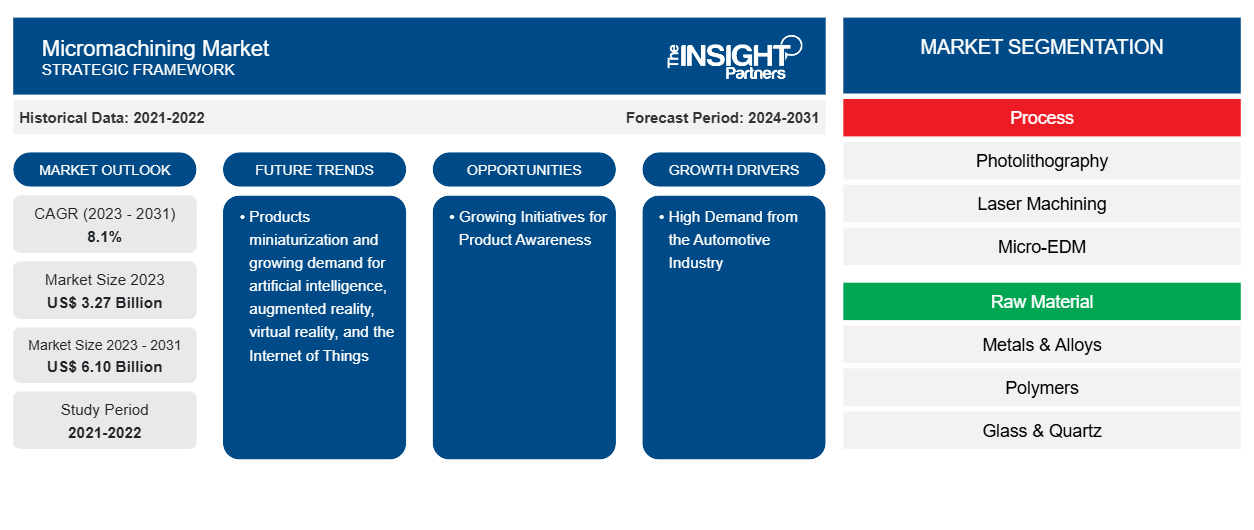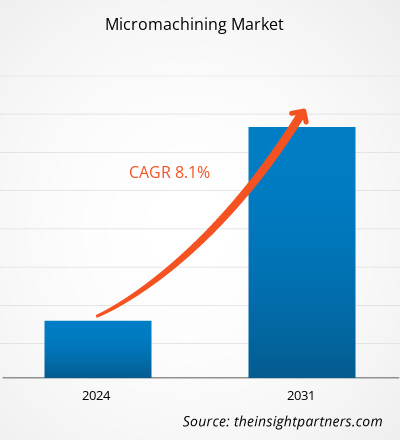The micromachining market size is projected to reach US$ 6.10 billion by 2031 from US$ 3.27 billion in 2023. The market is expected to register a CAGR of 8.1% in 2023–2031. Products miniaturization and growing demand for artificial intelligence, augmented reality, virtual reality, and the Internet of Things are likely to remain key micromachining market trends.
Micromachining Market Analysis
The micromachining market is growing at a rapid pace due to the high demand from the automotive industry and the rising use of laser machining and electrochemical machining. The market is expanding steadily, driven by the increasing government spending to expand the automotive industry and the growing production of electric vehicles. Moreover, the growing initiatives for product awareness and the development of sensor fusion technology are providing lucrative opportunities for market growth.
Micromachining Market Overview
Micromachining is the process of creating 3D and 2D structures at the micrometer scale. Prior to technological advancements, watch parts were considered tiny components; nevertheless, micro components have subsequently been used in a range of industries, including electronics and biomedical implants. Micromachining applications, such as welding, cutting, 3D machining, and micro-milling, have grown in response to increased demand for compact, cost-effective, and practical goods in industries such as semiconductors and electronics, automotive, aerospace, and medicine. Improvements in these industries are creating significant growth opportunities for the market. Additionally, the adoption of micromachining for micro-component production in the automotive, consumer electronics, healthcare, and aerospace industries is driving the market.
Customize This Report To Suit Your Requirement
You will get customization on any report - free of charge - including parts of this report, or country-level analysis, Excel Data pack, as well as avail great offers and discounts for start-ups & universities
Micromachining Market: Strategic Insights

-
Get Top Key Market Trends of this report.This FREE sample will include data analysis, ranging from market trends to estimates and forecasts.
Micromachining Market Drivers and Opportunities
High Demand from the Automotive Industry is Driving the Market
Micromachining is becoming increasingly popular in the automotive industry due to its widespread use. It is used in fuel injection technology, specifically fuel injector nozzles. Fuel injection technology boosts vehicle mileage. Fuel injector nozzles are micromachined using the EDM process. The use of laser technology in micromachining in the automobile industry raises the necessity for seamless welding and bonding for various vehicle components. Furthermore, micromachining also supports the car in consuming less fuel, which increases its demand among consumers and drives the market.
Additionally, the growing demand for electric vehicles among consumers is boosting the market during the forecast period. Micromachining is extensively used in the construction of electrovoltaic cells, which has greatly expanded the automotive industry. However, the expanding automotive industry and increasing demand for electric vehicles among consumers across the globe are driving the market during the forecast period.
Growing Initiatives for Product Awareness - An Opportunity in the Micromachining Market
In recent years, the number of consumer-awareness-raising events has increased, and governments of various nations are planning to schedule micromachining-based events or conferences to create awareness among users. For instance, The International Research Conference is planning to organize an International Conference on Micromachining (ICM) scheduled on June 27-28, 2024, in Istanbul, Türkiye. This conference covers all aspects of micromachining, including the most recent breakthroughs, trends, and concerns, as well as real issues faced and solutions implemented in the field of micromachining, which has accelerated market growth in the near future.
Micromachining Market Report Segmentation Analysis
Key segments that contributed to the derivation of the micromachining market analysis are process, raw material, and application.
- Based on the process, the micromachining market is divided into photolithography, laser machining, micro-EDM, and micromechanical machining. The laser machining segment is segmented into CO2 Laser Micromachining, IR laser micromachining, green laser micromachining, and UV laser micromachining. The photolithography segment held a larger market share in 2023.
- On the basis of raw materials, the market is segmented into metals & alloys, polymers, glass & quartz, and ceramics. The polymers segment held a larger market share in 2023.
- In terms of application, the micromachining market is categorized as aerospace & defense, medical, telecommunications, semiconductor & electronics, automotive, industrial, and others. The automotive segment held a larger market share in 2023.
Micromachining Market Share Analysis by Geography
The geographic scope of the micromachining market report is mainly divided into five regions: North America, Asia Pacific, Europe, Middle East & Africa, and South America/South & Central America.
In terms of revenue, the Asia Pacific market accounted for the largest micromachining market share due to the presence of major automotive component manufacturers in countries including China, India, and South Korea. These manufacturers are highly demanding micromachining for manufacturing major automobile components such as fuel injectors, electrical assemblies, and automotive sensors. Furthermore, growing awareness related to the benefits provided by micromachining and rising demand from the railway and energy industry is boosting the market.
Micromachining Market Regional Insights
The regional trends and factors influencing the Micromachining Market throughout the forecast period have been thoroughly explained by the analysts at The Insight Partners. This section also discusses Micromachining Market segments and geography across North America, Europe, Asia Pacific, Middle East and Africa, and South and Central America.
Micromachining Market Report Scope
| Report Attribute | Details |
|---|---|
| Market size in 2023 | US$ 3.27 Billion |
| Market Size by 2031 | US$ 6.10 Billion |
| Global CAGR (2023 - 2031) | 8.1% |
| Historical Data | 2021-2022 |
| Forecast period | 2024-2031 |
| Segments Covered |
By Process
|
| Regions and Countries Covered |
North America
|
| Market leaders and key company profiles |
|
Micromachining Market Players Density: Understanding Its Impact on Business Dynamics
The Micromachining Market is growing rapidly, driven by increasing end-user demand due to factors such as evolving consumer preferences, technological advancements, and greater awareness of the product's benefits. As demand rises, businesses are expanding their offerings, innovating to meet consumer needs, and capitalizing on emerging trends, which further fuels market growth.

- Get the Micromachining Market top key players overview
Micromachining Market News and Recent Developments
The micromachining market is evaluated by gathering qualitative and quantitative data post primary and secondary research, which includes important corporate publications, association data, and databases. The following is a list of developments in the market for micromachining and strategies:
- In August 2023, Posalux Group unveiled two machines: the ULTRASPEED MONO and the ULTIMATE DUO at SEMICON Europa 2023. The event co-located with Productronica, scheduled to take place from November 14th to 17th in Munich, Germany, promises to be a momentous occasion for those interested in the forefront of mechanical micromachining technology. (Source: Posalux Group, Press Release, 2023)
Micromachining Market Report Coverage and Deliverables
The “Micromachining Market Size and Forecast (2021–2031)” report provides a detailed analysis of the market covering below areas:
- Market size and forecast at global, regional, and country levels for all the key market segments covered under the scope
- Market dynamics such as drivers, restraints, and key opportunities
- Key future trends
- Detailed PEST/Porter’s Five Forces and SWOT analysis
- Global and regional market analysis covering key market trends, major players, regulations, and recent market developments
- Industry landscape and competition analysis covering market concentration, heat map analysis, prominent players, and recent developments
- Detailed company profiles
Frequently Asked Questions
What is the incremental growth of the global micromachining market during the forecast period?
What will be the market size of the global micromachining market by 2031?
Which are the key players holding the major market share of the global micromachining market?
What are the future trends of the global micromachining market?
What are the driving factors impacting the global micromachining market?
What is the estimated market size for the global micromachining market in 2023?
- Historical Analysis (2 Years), Base Year, Forecast (7 Years) with CAGR
- PEST and SWOT Analysis
- Market Size Value / Volume - Global, Regional, Country
- Industry and Competitive Landscape
- Excel Dataset
Recent Reports
Testimonials
Reason to Buy
- Informed Decision-Making
- Understanding Market Dynamics
- Competitive Analysis
- Identifying Emerging Markets
- Customer Insights
- Market Forecasts
- Risk Mitigation
- Boosting Operational Efficiency
- Strategic Planning
- Investment Justification
- Tracking Industry Innovations
- Aligning with Regulatory Trends





















 Get Free Sample For
Get Free Sample For